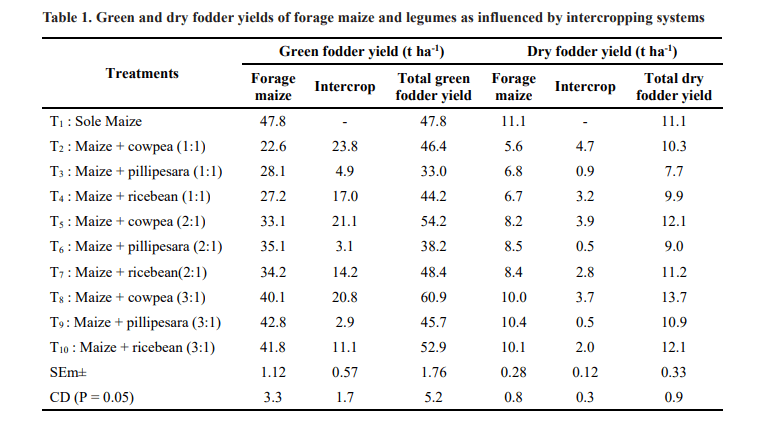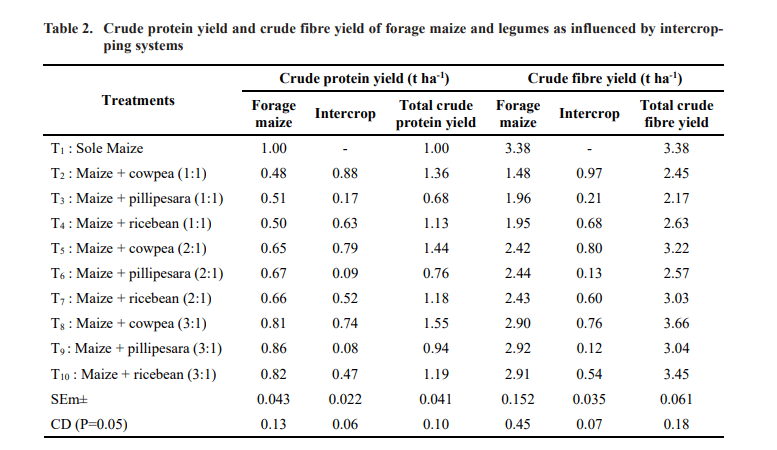Productivity and Quality of Forage Maize Under Different Legume Intercropping Systems
0 Views
ABSTRACT
A field experiment was conducted during kharif, 2019 on sandy loam soils of Wetland farm of S.V. Agricultural College, Tirupati campus of Acharya N.G. Ranga Agricultural University. The results of the experiment revealed that intercropping system of maize + cowpea in 3:1 ratio recorded significantly higher total green fodder and dry fodder yield. Quality parameters like crude protein and crude fibre yield were also high in maize + cowpea intercropping system in 3:1 ratio, followed by maize + cowpea in 2:1 ratio.
KEY WORDS:
Forage maize, intercropping system, cowpea, fodder yield
INTRODUCTION
India is the largest country which is having 536 million livestock population. Fodder production is a foremost determining factor for a flourishing livestock enterprise in India. Agricultural land is declining day by day owing to non agricultural purposes. It is generally quite impossible to set aside cultivable land exclusively for fodder cultivation, as it is not sufficient for food crop production. Currently, total area under fodder crops is
8.6 m ha which accounts for less than 4.5 per cent of area under cultivation and is inadequate to meet the fodder requirement of actually existing livestock. It is rather necessary to incorporate fodder production in existing cropping systems. Also, majority of the fodder crops cultivated on marginal lands along with monocultures are deficient in qualitative and nutritive traits. Fodder rich in these traits can only solve problem of malnutrition in animals.
The primary objective of forage maize production is to supply nutritive fodder in correspondence with feed requirement of cattle. Even though maize gives high yield in terms of dry matter yield, it produces fodder with less protein content. Therefore, it is necessary to enhance forage quality by mixing suitable fodder legumes without reduction in forage yield. The low protein concentration in forage maize can be augmented by inclusion of forage legumes as they are rich in proteins. High quality of forage has been informed as a vital feature of forage crop
production. Legumes have high quality forage, but low dry matter content. Therefore, cereal legume combination is deliberated as a management strategy in generating both high quality and quantity of forage.At present, maize- legume intercropping system is given global attention due to its leading importance in world agriculture. The fodder yield and protein yield of forage were enhanced by all intercropping compositions as compared to the maize monocultures (Javanmard et al., 2009). Accordingly, this study was carried out to assess the green fodder yield and quality in terms of fodder yield and protein yield using different intercropping systems.
MATERIAL AND METHODS
The field experiment was conducted during kharif, 2019 at Wetland farm of S.V. Agricultural College, Tirupati campus of Acharya N.G. Ranga Agricultural University, Andhra Pradesh. The soil of experimental site was sandy clay loam having 0.25% organic carbon, 160 kg ha-1, 15.25 kg ha-1 and 265 kg ha-1 of available N, P2O5 and K2O respectively. A total rainfall received during the crop period was 460.4mm in 24 rainy days. The experiment was laid out in a randomized block design with ten treatments comprised of sole maize (T1), maize+ cowpea (1:1) (T2), maize + pillipesara (1:1) (T3), maize+ ricebean (1:1) (T4), maize + cowpea (2:1) (T5), maize + pillipesara (2:1) (T6), maize + ricebean (2:1) (T7), maize+ cowpea (3:1) (T8), maize + pillipesara (3:1) (T9) and maize + ricebean (3:1) (T10) (Table 1). Forage maize as


well as intercrops were sown in lines, 30 cm apart by adopting all the standard package of practices.The recommended fertilizer dose of 120 kg N, 50 kg P2O5 and 40 kg K2O ha-1 was applied only for forage maize.Half of the dose of N and whole amount of P and K was applied as basal and the remaining half dose of nitrogen was applied at 30 DAS. Maize and legume intercrops were harvested for green fodder purpose at 70 DAS. The treatment wise green fodder yield of maize and intercrops were harvested from each net plot. The quality parameters such as crude protein yield and crude fibre yield were estimated in the laboratory by using the standard procedures as recommended by A. O. A. C (1990).
RESULTS AND DISCUSSION
Green and dry fodder yields were significantly affected by different intercropping systems (Table 1). The total green and dry fodder yields were higher with maize + cowpea intercropping system in 3:1 ratio and significantly superior to the other intercropping systems and sole maize. Significantly lower total green and dry fodder yields were recorded with maize + pillipesara intercropping system in 1:1 ratio.
The higher total green forage yields in intercropping system of maize with cowpea in 3:1 ratio might be attributed to complementary effect of cowpea, which might have supplemented nitrogen to maize and the better utilization of solar radiation, space and nutrients from soil by maize + cowpea intercropping system. Furthermore, increase in total green forage yields in the intercropping systems might be owing to better utilization of space and light interception coupled with nutrient contribution of leguminous fodder to cereal. The increase in dry fodder yield was also due to increase in green forage yield in intercropping treatments. These results were in accordance with the findings of Sharma et al. (2008) and Asangla and Gohain (2016).
The influence of intercropping system of maize with cowpea in 3:1 ratio was clearly evident in total crude protein and crude fibre yield (Table 2). Significantly higher total crude protein and crude fibre yield of the system was recorded with maize+ cowpea (3:1) over the other intercropping systems.
The difference in quality parameters in all the intercropping systems were noticed mainly due to variation in dry fodder yields of maize, cowpea, pillipesara and ricebean, which was the reflection of
contribution from both the component crops resulting in enhanced production of quality components through complementary relationship. Similar findings were also reported by Yilma (2002) and Chotiya (2005).
CONCLUSION
The study has revealed that intercropping of forage maize with cowpea in 3:1 row proportion, was proved to be suitable and economically sustainable for realizing higher productivity and quality during kharif season for Southern Agro-climatic Zone of Andhra Pradesh.
LITERATURE CITED
A.O.A.C. 1990. Association of Official Analytical Chemists: Changes in Official methods of Analysis. 14th edition. Arlington, U.S.A. 71.
Asangla, H.K and Gohain, T. 2016. Effect of fodder yield and quality attributes of maize (Zea mays) and cowpea (Vigna unguiculata) intercropping and different nitrogen levels. International Journal of Agricultural Science and Research. 6(2): 349-356.
Chotiya, G.S. 2005. Companion cropping of maize with legumes for forage. Madras Agricultural Journal. 89(4): 233-238
Javanmard, A., Mohammadi, N., Javanshir, A., Mohammad, M and Janmohammadi, H. 2009. Forage yield and quality in intercropping of maize with different legumes as double cropped. Journal of Food, Agriculture and Environment. 7(1): 163-166.
Sharma, R.P., Singh, A.K., Poddar, B.K and Raman K.R. 2008. Forage production potential and economics of maize (Zea mays) with legumes intercropping under various row proportions. Indian Journal of Agronomy. 53(2): 121-124.
Yilma, K. 2002. Effect of cropping systems, nitrogen levels and bacterial fertilization on yield and quality of fodder sorghum (Sorghum bicolor L.). Ph.D Thesis. Maharana Pratap University of Agriculture and Technology, Rajasthan, India.
- Bio-Formulations for Plant Growth-Promoting Streptomyces SP.
- Brand Preference of Farmers for Maize Seed
- Issues That Consumer Experience Towards Online Food Delivery (Ofd) Services in Tirupati City
- Influence of High Density Planting on Yield Parameters of Super Early and Mid Early Varieties of Redgram (Cajanus Cajan (L.) Millsp.)
- Influence of Iron, Zinc and Supplemental N P K on Yield and Yield Attributes of Dry Direct Sown Rice
- Effect of Soil and Foliar Application of Nutrients on the Performance of Bold Seeded Groundnut (Arachis Hypogaea L.)

